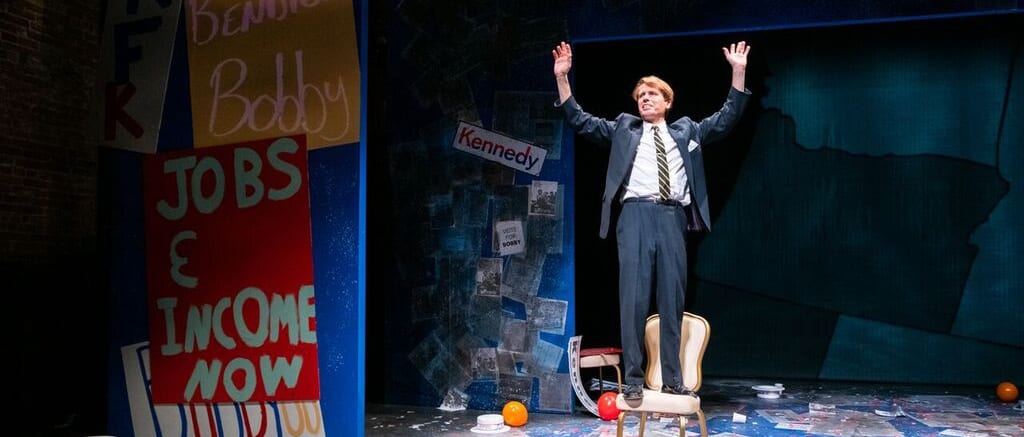Marking 50 years since the death of Robert F. Kennedy, the new solo show “Kennedy: Bobby’s Last Crusade” chronicles the four months of RFK’s 1968 presidential campaign, from his announcement in the Senate Caucus Room to run against Senator McCarthy and President Johnson through to his last speech in the Ambassador Hotel in Los Angeles where he was later fatally shot on June 4th.
The play is written and performed by David Arrow and pulls directly from RFK’s most sympathetic and encouraging speeches on civil rights, poverty, health care and anti-war sentiments in the Democratic party. Director Eric Nightengale constructs a clear world that transitions well between these historic speeches and his more personal reflections.
The play opens in the sparse ballroom of the Ambassador Hotel, where a recently deceased Bobby appears in a limbo state (maybe it’s the 26 hours he stayed alive after the shooting?) as he highlights the events of his presidential campaign leading up to his assassination. As the actor portraying RFK, David Arrow bears an incredible resemblance to Bobby and he skillfully crafted a brilliant rendering of the man, capturing Bobby’s mannerisms and his famous New Englander accent. However, the iconic, and potentially hyperbolic, Kennedy charm was slightly lacking during Bobby’s speeches.

As a playwright, David cleverly creates the foundation for strong character development that follows alongside the success of RFK’s bid to become the Democratic candidate for President. At the start of the play, David allows for a quieter, less assured Bobby, commenting on his own nervous energy and shaking hands. By the plays end, after victories in Indiana, South Dakota, Nebraska and California, it’s with greater confidence and a steadier hand that Bobby confesses that “I feel like I finally shook off the shadow of my brother – I feel for the first time I’m going to win.”
Scenic designer James Morgan uses a frame within a frame to contain the action of the piece, as RFK election swag and slogans decorate the perimeter with “Bobby’s Great for ‘68” and “We Have a Right for Jobs and Income Now.” Lighting designer Miriam Nilofa Crowe uses parts of the frame and the background to track all the action that unfolds leading up to the assassination and events that happen alongside the campaign, with newspaper headlines from President Johnson’s announcement to not run for re-election and the assassination of Dr. Martin Luther King Jr.
There’s no disputing that the ’60s were filled with progressive wins and tragic fallout. Robert F. Kennedy built a campaign against the establishment’s support of a senseless war; he challenged gun owners; he fought for health care and shed a light on domestic poverty; he was a civil rights advocate that told white voters they needed to do more and care more for their black neighbors. In “Kennedy: Bobby’s Last Crusade” Bobby poignantly says, “Ever since I decided to run I knew there’d be guns between me and the White House,” and he ran anyway. Some called RFK an opportunist; others, a revolutionary. However you see him, there’s no disputing that having someone like Bobby running today would give hope in a time where lines are continuously being crossed and precedents set that 50 years ago would’ve seemed unthinkable.
“Kennedy: Bobby’s Last Crusade” is a play of hope and encouragement in a time where we need it most.

